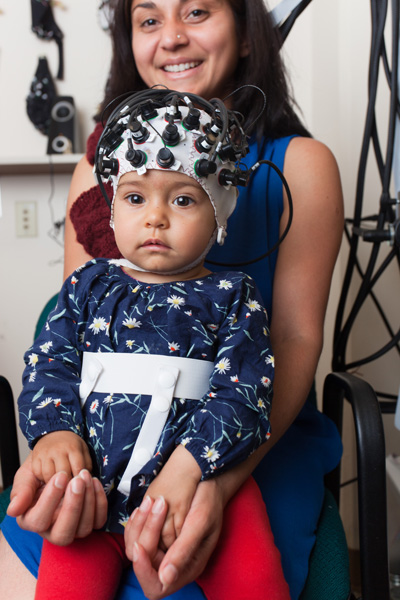As a developmental social neuroscience lab, we use infant-friendly psychophysiology measures to investigate infant social development. Below are five measures currently used in the lab and example studies using each measurement.
For all studies in the lab, you will either be holding your child or sitting near them while they sit in a high chair. Each visit lasts about an hour, with the study itself lasting about 15-20 minutes.
EEG: Electroencephalography (EEG) measures the electrical signals emanating from the scalp, which serve as a proxy measure for the brain activity occurring directly underneath the scull. These signals are measured by placing a cap full of sensors on the infant’s head. Each sensor is filled with gel (similar to the gel used in an ultrasound) to improve signal detection. The cap and gel are harmless but a good shampoo post study might be needed to remove excess gel!
Using EEG, we recently found that 7-month-old infants register the presence of fearful eye expressions, even outside of conscious awareness. Click here to read this study in full.
 fNIRS: Functional near infrared spectroscopy (fNIRS) is similar to EEG in that infants have a cap placed on their head, containing a series of sensors. Instead of reading electrical signals off the scalp, the fNIRS cap projects harmless infrared light beams toward the brain. Sensors adjacent to the light beams take readings on the light that passes through and measure the rate of light deflection to detect hemodynamic (change in the oxygen content of the blood) response over time. Note that this is similar to how fMRI works in that they both measure hemodynamic response, making this a very exciting way to extend adult brain work to infants.
fNIRS: Functional near infrared spectroscopy (fNIRS) is similar to EEG in that infants have a cap placed on their head, containing a series of sensors. Instead of reading electrical signals off the scalp, the fNIRS cap projects harmless infrared light beams toward the brain. Sensors adjacent to the light beams take readings on the light that passes through and measure the rate of light deflection to detect hemodynamic (change in the oxygen content of the blood) response over time. Note that this is similar to how fMRI works in that they both measure hemodynamic response, making this a very exciting way to extend adult brain work to infants.
Using fNIRS, we recently found that infants as young as 5 month old are sensitive to when a social partner follows their gaze to look at the same object. Click here to read this study in full.
Heart Rate: Heart rate deceleration is a naturally occurring process that informs us of how intensely an infant is attending to something. An infant may look at two objects an equal amount of time; however their attention (and heart rate deceleration) may differ based on the the object or stimuli. Heart rate is measured using three sensor stickers placed on the infant’s back or with a pulse oximeter placed on the infant’s toe.
Measuring heart rate, we found that 8-to-10-month-old infants are sensitive to pleasant touch as shown by greater heart rate deceleration to slow, soft brushing on their forearm. Click here to read this study in full.
Eye Tracking: We use eye tracking technology in order to understand where and how long infants are looking at specific features of an image (often times faces). Eye tracking is measured by recording the reflection of infrared light off of the eyes while the infant watches displays on a monitor.
Using eye tracking measures, we found that infants with a certain genetic marker (but not those without the marker) who were exclusively breast fed for longer periods of time showed a greater preference for viewing happy eyes compared to angry eyes. Click here to read this study in full.
Pupil Dilation: Another measure which can be obtained from eye tracking is pupil dilation. Similar to heart rate, pupil dilation is an indicator of how aroused our autonomic nervous system is at any given time. Arousal of the nervous system is thought to facilitate evolutionarily adaptive responding to relevant things in our environment.
Measuring pupil dilation, we recently found that 7-month-old infants respond differently to fearful and happy faces even when they are presented outside of conscious awareness. Click here to read this study in full.